The spore producing mi - Study guides, Class notes & Summaries
Looking for the best study guides, study notes and summaries about The spore producing mi? On this page you'll find 17 study documents about The spore producing mi.
All 17 results
Sort by

-
ACE ASCP Final Exam Questions and Answers, Latest Updated 2024/2025 | Rated A+
- Exam (elaborations) • 225 pages • 2024
-
- $17.49
- + learn more
ACE ASCP Final Exam Questions and Answers, Latest Updated 2024/2025 | Rated A+. Which of the following condition is the most common cause of increase anion gap? A.Metabolic alkalosis B. Metabolic acidosis Respiratory acidosis Respiratory alkalosis B. Metabolic acidosis High anion gap metabolic acidosis is caused generally by the body producing too much acid or not producing enough bicarbonate. This is often due to an increase in lactic acid or ketoacids, or it may be a sign of kidney fail...
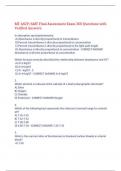
-
MT ASCP/AMT Final Assessment Exam 300 Questions with Verified Answers,100% CORRECT
- Exam (elaborations) • 65 pages • 2024
-
- $13.49
- + learn more
MT ASCP/AMT Final Assessment Exam 300 Questions with Verified Answers In absorption spectrophotometry: A) Absorbance is directly proportional to transmittance B) Percent transmittance is directly proportional to concentration C) Percent transmittance is directly proportional to the light path length D) Absorbance is directly proportional to concentration - CORRECT ANSWER Absorbance is directly proportional to concentration Which formula correctly described the relationship between ...
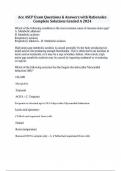
-
Ace ASCP Exam Questions & Answers with Rationales Complete Solutions Graded A 2024
- Exam (elaborations) • 129 pages • 2024
- Available in package deal
-
- $14.00
- + learn more
Which of the following condition is the most common cause of increase anion gap? A. Metabolic alkalosis B. Metabolic acidosis Respiratory acidosis Respiratory alkalosis - B. Metabolic acidosis High anion gap metabolic acidosis is caused generally by the body producing too much acid or not producing enough bicarbonate. This is often due to an increase in lactic acid or ketoacids, or it may be a sign of kidney failure. More rarely, high anion gap metabolic acidosis may be caused by ingesting meth...
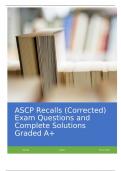
-
ASCP Recalls (Corrected) Exam Questions and Complete Solutions Graded A+
- Exam (elaborations) • 76 pages • 2024
- Available in package deal
-
- $13.49
- + learn more
3 pairs of hooklets in an ovum - Answer: Hymenolepis Diminuta Which is the agent of hand, foot and mouth disease of humans? - Answer: Coxsackie A virus Detection of antigen in urine specimen can be used for which of the following type of pneumonia infection a. Fusobacterium B. Y. Pestis C. Legionella D. Mycobacterium TB. - Answer: Legionella Antler hyphae found in ... - Answer: Microsporum Audouinii What grows on chocolate agar - Answer: Haemophilus spp. *requires X a...
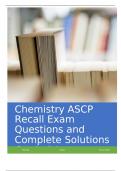
-
Chemistry ASCP Recall Exam Questions and Complete Solutions Graded A+.
- Exam (elaborations) • 3 pages • 2024
-
- $13.49
- + learn more
3 pairs of hooklets in an ovum - Answer: Presence of lupus anticoagulant leads to .... Which is the agent of hand, foot and mouth disease of humans? - Answer: Coxsackie A virus Detection of antigen in urine specimen can be used for which of the following type of pneumonia infection a. Fusobacterium B. Y. Pestis C. Legionella D. Mycobacterium TB. - Answer: Legionella Antler hyphae found in ... - Answer: Microsporum Audouinii What grows on chocolate agar - Answer: Haemop...

-
MT ASCP/AMT Final Assessment Exam 300 Questions with Verified Answers,100% CORRECT
- Exam (elaborations) • 65 pages • 2024
-
- $12.99
- + learn more
MT ASCP/AMT Final Assessment Exam 300 Questions with Verified Answers In absorption spectrophotometry: A) Absorbance is directly proportional to transmittance B) Percent transmittance is directly proportional to concentration C) Percent transmittance is directly proportional to the light path length D) Absorbance is directly proportional to concentration - CORRECT ANSWER Absorbance is directly proportional to concentration Which formula correctly described the relationship between ...

-
MLT ASCP Practice Questions Already Graded A+
- Exam (elaborations) • 31 pages • 2022
-
- $19.99
- + learn more
A What is the cell that is indicated by the arrow in this field? A. Red cell fragment B. Acanthocyte C. Burr cell D. Crenated cell D A young man is experiencing difficult breathing after fainting. The physician orders a blood gas analysis which shows the following results: pH = 7.25 pCO2 = 62 mmHg pO2 = 70 mmHg HCO3 = 23 mEq/L Which condition is most likely afflicting this patient? A. metabolic alkalosis B. metabolic acidosis C. respiratory alkalosis D. respir...
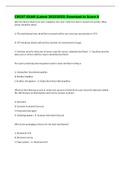
-
CRCST EXAM (Latest 2022/2023) Download to Score A
- Exam (elaborations) • 19 pages • 2022
- Available in package deal
-
- $11.49
- + learn more
CRCST EXAM (Latest 2022/2023) Download to Score A
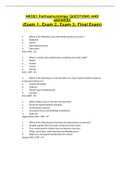
-
NR283 Pathophysiology QUESTIONS AND ANSWERS (Exam 1, Exam 2, Exam 3, Final Exam)
- Exam (elaborations) • 160 pages • 2022
-
- $25.99
- + learn more
NR283 Pathophysiology QUESTIONS AND ANSWERS (Exam 1, Exam 2, Exam 3, Final Exam) 1. Which of the following areas lacks blood vessels and nerves? a. Epidermis b. Dermis c. Subcutaneous tissue d. Fatty tissue ANS: A REF: 142 2. What is a raised, thin-walled lesion containing clear fluid called? a. Papule b. Pustule c. Vesicle d. Macule ANS: C REF: 143 3. Which of the following is a common effect of a type I hypersensitivity response to ingested substances? a. Contact dermati...
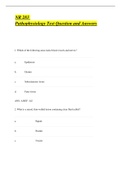
-
NR 283 Pathophysiology Test Question and Answers
- Exam (elaborations) • 351 pages • 2022
-
- $31.49
- + learn more
NR 283 Pathophysiology Test Question and Answers 1. Which of the following areas lacks blood vessels and nerves? a. Epidermis b. Dermis c. Subcutaneous tissue d. Fatty tissue ANS: A REF: 142 2. What is a raised, thin-walled lesion containing clear fluid called? a. Papule b. Pustule c. Vesicle d. Macule ANS: C REF: 143 3. Which of the following is a common effect of a type I hypersensitivity response to ingested subst...

How much did you already spend on Stuvia? Imagine there are plenty more of you out there paying for study notes, but this time YOU are the seller. Ka-ching! Discover all about earning on Stuvia


